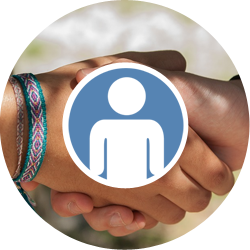Het arrangement 1.1 Introducing yourself - tto123 is gemaakt met Wikiwijs van Kennisnet. Wikiwijs is hét onderwijsplatform waar je leermiddelen zoekt, maakt en deelt.
- Auteur
- Laatst gewijzigd
- 11-05-2025 17:59:47
- Licentie
-
Dit lesmateriaal is gepubliceerd onder de Creative Commons Naamsvermelding-GelijkDelen 4.0 Internationale licentie. Dit houdt in dat je onder de voorwaarde van naamsvermelding en publicatie onder dezelfde licentie vrij bent om:
- het werk te delen - te kopiëren, te verspreiden en door te geven via elk medium of bestandsformaat
- het werk te bewerken - te remixen, te veranderen en afgeleide werken te maken
- voor alle doeleinden, inclusief commerciële doeleinden.
Meer informatie over de CC Naamsvermelding-GelijkDelen 4.0 Internationale licentie.
Aanvullende informatie over dit lesmateriaal
Van dit lesmateriaal is de volgende aanvullende informatie beschikbaar:
- Toelichting
- Deze les valt onder de arrangeerbare leerlijn van de Stercollectie voor Engels voor tweetalig onderwijs, leerjaar 1, 2 en 3. Dit is blok 1 'Personal'. Het onderwerp van deze les is: Introducing yourself. Het materiaal bespreekt de manier waarop iemand zich voor kan stellen en hoe iemand iets over zichzelf kan vertellen. Tijdens het onderdeel grammatica, wordt het werkwoord 'to be' geïntroduceerd. Bij het spreekopdracht kan er in groepjes geoefend worden met het over jezelf vertellen. Als laatst wordt er in de schrijfopdracht een formulier ingevuld.
- Leerniveau
- VWO 2; HAVO 1; VWO 1; HAVO 3; VWO 3; HAVO 2;
- Leerinhoud en doelen
- Engels;
- Eindgebruiker
- leerling/student
- Moeilijkheidsgraad
- gemiddeld
- Studiebelasting
- 1 uur 40 minuten
- Trefwoorden
- arrangeerbaar, engels, introducing yourself, jezelf voorstellen, over jezelf vertellen, stercollectie, to be, tto123
Gebruikte Wikiwijs Arrangementen
VO-content Engels. (2022).
1.1 Introducing yourself - hv12
https://maken.wikiwijs.nl/117769/1_1_Introducing_yourself___hv12
VO-content Engels. (2020).
11.3 Treatment - kgt34

 The subject of this period is introducing yourself.
The subject of this period is introducing yourself.

 Introduce yourself
Introduce yourself
 Introductions
Introductions To be able to do all the assignments correctly, you need to know some words and sentences.
To be able to do all the assignments correctly, you need to know some words and sentences.
 'To be' is an irregular verb.
'To be' is an irregular verb.
 Conversation
Conversation An email introducing yourself
An email introducing yourself What have you learnt in this double period?
What have you learnt in this double period?
